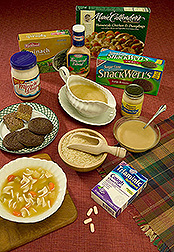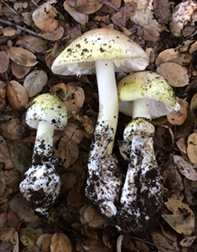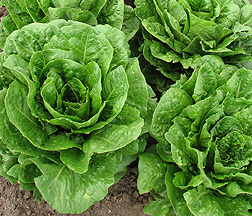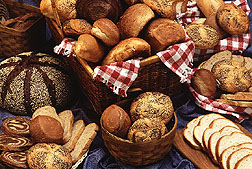
| July 2020 |
Brown Rice Variety Packs Vitamin E PunchThe brown rice GEDrew has an odd kernel trait that sidelined its commercial prospects. Now, Agricultural Research Service (ARS) scientists' re-examination of this trait and its link to increased antioxidant levels could give the rice variety a new commercial lease on life. GEDrew is the result of a mutagenesis rice breeding program conducted more than a decade ago. The GEDrew investigation focused on a single gene mutation that results in kernels with enlarged, or "giant," embryos. In addition to a higher proportion of bran to whole-kernel weight, the researchers observed that the giant embryo trait also correlated to a three-fold increase in alpha-tocopherol and a 20- and 29-percent increase in total tocotrienols and gamma-oryzanol, respectively. Even though GEDrew produced slightly smaller grains, it was unmatched in terms of its yield of bran, lipids and the three antioxidants. All are high-value ingredients for specialty uses ranging from edible oil for cooking and salad dressings, to breakfast cereals, nutrition bars, beverages and skin-care products. Scientific contact: Anna M. McClung, (870) 672-9300 ext. 275, Dale Bumpers National Rice Research Center, Stuttgart, Arkansas. |
|
Freeze-Dried Strawberries and Ice Cream Make for a Very Stable RelationshipARS researchers have shown some freeze-dried berry powders—especially freeze-dried strawberry powder—can act as outstanding stabilizers in ice cream and other frozen dairy desserts. Freeze-dried strawberry powder is so effective a stabilizer that frozen dairy desserts with it included will maintain their shape even after reaching room temperature. Freeze-dried berry powder will absorb moisture from the premix base, improving its stability and texture to the point where the frozen dessert will keep its shape even after "melting" to room temperature. Strawberry powder was the best stabilizer, completely preventing melt‐down, followed closely by raspberry. While blackberry powder prevented the frozen dessert from wheying off (leaking of a clear watery serum), the foam structure still collapsed so it lost its original shape. Blueberry powder, on the other hand, did not prevent melt-down or ice crystal formation during refreezing, and the frozen dessert showed a little wheying off. Scientific contact: Cristina Bilbao-Sainz, (510)559-5864, Healthy Processed Foods Research Unit, Western Regional Research Center, Albany, California. |
|
New Test Identifies Poisonous MushroomsA simple, portable test that can detect the deadliest of the mushroom poisons in minutes has been developed by ARS scientists and their colleagues. Eating toxic mushrooms causes more than 100 deaths a year, globally, and leaves thousands of people in need of urgent medical assistance. Amanitin is the class of mushroom toxins that cause the most serious issues. The new test can identify the presence of as little as 10 parts per billion (equivalent to 10 cents out of $10 million) of amanitin in about 10 minutes from a rice grain size sample of a mushroom or in the urine of someone who has eaten a poisonous amanitin-containing mushroom. No definitive point-of-care clinical diagnostic test currently exists for amatoxin poisoning. Early detection of amanitin in a patient's urine would help doctors trying to make a diagnosis. Scientific contact: Candace Bever, 510) 559-5833, Foodborne Toxin Detection and Prevention Research Unit, Western Regional Research Center, Albany, California. |
|
New Freeze-Resistant Trichinella Species DiscoveredA new freeze-resistant Trichinella species has been discovered in wolverines by Agricultural Research Service scientists and their colleagues. This is the first species of Trichinella discovered since 2012, and the 13th species identified since the genus was discovered in 1835. The new species, now named Trichinella chanchalensis (and nicknamed "oddball"), was found in 14 of 338 wolverine samples tested. About 70 percent of the wolverine samples were infected by some Trichinella species. The samples were all provided by Canadian authorities that oversee trappers and/or game meat food safety in that country. Wolverines make an excellent sentinel species to help understand the scope of Trichinella in the environment. When the researchers first saw the new freeze-resistant Trichinella, they sought to understand if there had been interbreeding between T. nativa and T6, another freeze-resistant variety that is closely related to T. nativa. Evolutionarily, the evidence shows that Trichinella chanchalensis split off from the other known Trichinella species about 6 million years ago, making it a very old species among Trichinella. That brings up the question of how T. nativa and T6 got their freeze resistance. Did the trait evolve more than once or is there some other mechanism at work? Scientific contact: Benjamin Rosenthal, 301-504-8300, Animal Parasitic Diseases Laboratory, Beltsville Agricultural Research Center, Beltsville, Maryland. |
|
Researchers Identify Romaine Lettuces That Last LongerFive Romaine lettuce varieties have been identified that both brown less quickly after fresh-cut processing and are slower to deteriorate postharvest. They also are determining the genetic basis for deterioration. The researchers have identified the location of genes associated with postharvest deterioration of fresh-cut lettuce, and are in the process of identifying genes associated with browning, two economically important traits. This will speed up development of new Romaine varieties with better shelf-life because now lettuce breeders will be able to check that offspring carry these genes without needing to grow out and destructively test for browning and deterioration resistance. Lettuces are the most popular, commercially produced, leafy vegetables in the world. It had a farmgate value of more than $2.5 billion in the United States in 2017, making it one of top ten most valuable crops for the country. Scientific contact: Ivan Simko, (831) 755-2862, Crop Improvement and Protection Research Unit, Salinas, California. |
|
Three Joy Peaches ReleasedThe Agricultural Research Service (ARS) has released a trio of Joy peaches—Rich Joy, Liberty Joy and Crimson Joy—to enhance the southeastern fresh peach market. Rich Joy is named for its fruit's rich flavor and as a way to honor ARS peach breeder William Richardson Okie, who retired in 2014. Okie is known for having developed the series of "prince" peach varieties, which are still in commercial use. Crimson Joy is named for its almost fully red-blushed skin. Liberty Joy is so called because it ripens near Fourth of July, Independence Day. The three Joy peaches are not genetically related. They are all yellow-fleshed, soften slowly to a smooth buttery texture (a trait called melting), with balanced sugar/acid ratios and pleasant eating quality. Scientific contact: Chunxian Chen, (478) 956-6467, Fruit and Tree Nut Research Unit, Byron, Georgia. |
|
Microbe with Taste for Stale Bread Finds Its CallingAn Agricultural Research Service (ARS) team in Peoria, Illinois, has devised a procedure for using bacteria to convert glucose from bread waste into value-added products such as ascorbic acid (vitamin C), which is used in everything from food and beverages to pharmaceutical and personal-care products, a U.S market valued at over $1 billion in 2018. By one estimate, 12.5 million tons of bread, rolls, croissants and other baked goods go uneaten worldwide each year. Some of this food waste is fed to livestock as a source of carbohydrates and protein; however, the remainder can pose a disposal problem. Fortunately, the adage "One man's trash is another man's treasure" still holds true—with the help of Pseudomonas reptilivora bacteria. Team members devised fermentation procedures that encourage the species to gobble up glucose in bread waste and convert it into 2-keto-D-gluconic acid (2KGA), a so-called "platform chemical" that helps synthesize bulk quantities of erythorbic acid, ascorbic acid, ascorbic acid salts, and other substances with wide-ranging food and industrial applications. 2KGA itself can also be used as a detergent builder, cement plasticizer and precursor chemical for herbicide compounds. The team's hope is that with continued research and scale-up, the glucose-hungry bacteria will offer a biobased alternative to synthetically producing valuable chemicals like vitamin C from 2KGA—and simultaneously help tackle a food-waste issue. Scientific contact: Badal C. Saha, (309) 681-6276, Bioenergy Research Unit, National Center for Agricultural Utilization Research, Peoria, Illinois. |
|








